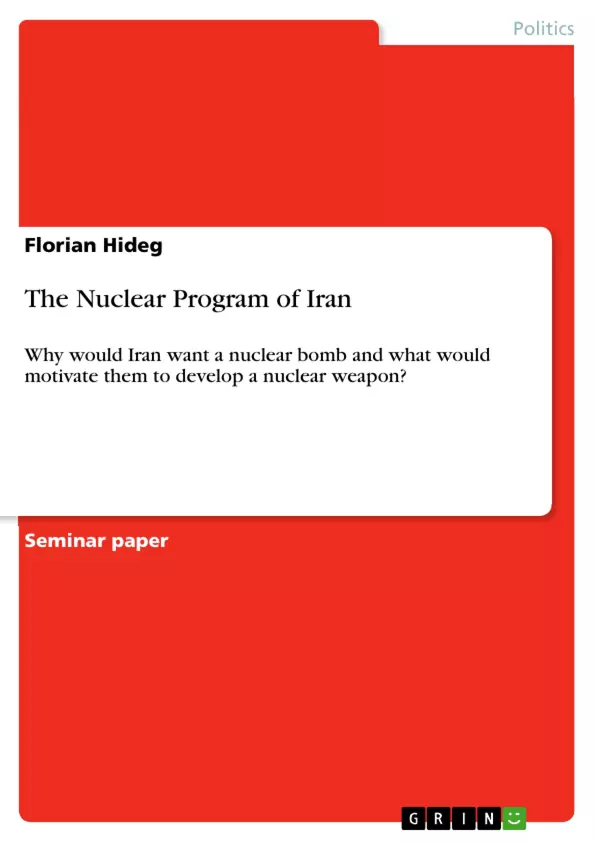Since the uprising in North Africa and the Middle East and the horrific tsunami in Japan the nuclear program of Iran moved into the background of international politics. But the issue is still newsworthy. For many years Iran is in a negative focus of Western governments and media. The reason for this is the speculation about the secret development of a nuclear bomb by Iran in coherence with its nuclear program. There has been some evidence that Tehran strives for becoming a nuclear power. In 2002 the uranium enrichment plant in Natanz and the heavy-water reactor in Arak were detected. The International Atomic Energy Agency (IAEA) started their investigations, but could not find any sign for a military nuclear program, although they talk about a “policy of deception” by Iran. They stated therefore simply:
“Iran has failed to meet its obligations under its Safeguard Agreements with respect to the reporting of nuclear material, the subsequent processing and use of that material and the declaration of facilities where the material was stored and processed".
This event called up distrust by the West. The Western states, mainly the United States, Great Britain, France and Germany still accuse Iran to keep some parts of the nuclear program secret, while officials of the Iranian government try to assure the intention for a peaceful use of nuclear energy. One of the main problems is that a military nuclear program is hard to differ from a peaceful one. The difference between a peaceful nuclear program and a military nuclear program, with a nuclear bomb in its result, is only approximately 5 percent in the final-stage of the development. When Iran would have been built up the full nuclear cycle for a peaceful use of nuclear energy the country would have the possibility to develop nuclear weapons in a short time.
This leads necessarily to the question which of these positions is the right one. Does Iran really like to develop the nuclear bomb or is the fear of the West disproportionate? If Iran tries to use „atoms for peace“ there should be no problem, but the last years where characterized by secretiveness from the Iranian side towards the International Atomic Energy Agency (IAEA) and a lurching in the bargaining position during the negotiations with the United States and the EU-3 (Great Britain, France and Germany). To the Western civilization this seems as an indication for a secret military nuclear program...
Inhaltsverzeichnis (Table of Contents)
- Introduction
- The main features of neorealism to Iran's nuclear program
- Historical facts on Iran and its nuclear program
- 1951-1979
- 1979-2003
- 2003 today
- Motivation of Iran to become a nuclear power
- Energy policy
- The Big Satan and the Little Satan
- Iran as a regional power
- Arabian antagonism towards Iran
- American superiority in the Middle East
- Compensation of powerlessness during former conflicts and isolation
- Conclusion
Zielsetzung und Themenschwerpunkte (Objectives and Key Themes)
This paper aims to analyze Iran's nuclear program through the lens of neorealism theory. It seeks to answer the questions of why Iran might desire a nuclear bomb and what motivates them to pursue such a weapon. The paper explores the historical background of Iran's nuclear program and examines various motivations, including energy needs, security concerns, regional power aspirations, and the desire to compensate for past vulnerabilities.
- Iran's Nuclear Program
- Neorealism Theory and International Relations
- Motivation for Nuclear Development
- Iran's Security Environment and Regional Power Dynamics
- Historical Context and Past Conflicts
Zusammenfassung der Kapitel (Chapter Summaries)
The paper begins with an introduction to the topic, emphasizing the ongoing debate surrounding Iran's nuclear program. It then provides a brief overview of the main features of neorealism theory, which serves as the theoretical framework for the analysis.
Chapter 3 offers a historical overview of Iran's nuclear program, covering the periods from 1951 to 1979, 1979 to 2003, and from 2003 to the present.
Chapter 4 explores various motivations for Iran's pursuit of nuclear capabilities. It examines Iran's need for peaceful nuclear energy, the security threats posed by the United States and Israel, Iran's regional power aspirations, the antagonistic relationship with neighboring Arab states, and the potential for American military intervention in the Middle East. The chapter also delves into Iran's historical experience of isolation and vulnerability, particularly during the Gulf War.
Schlüsselwörter (Keywords)
This paper focuses on Iran's nuclear program, neorealism theory, international relations, security policy, regional power dynamics, energy policy, United States, Israel, Middle East, and historical conflicts.
- Arbeit zitieren
- M.A. Florian Hideg (Autor:in), 2011, The Nuclear Program of Iran, München, GRIN Verlag, https://www.grin.com/document/281770



